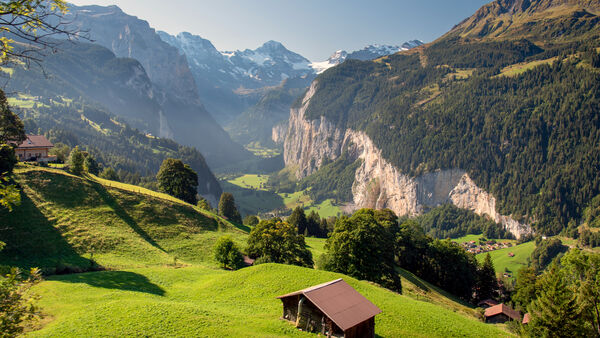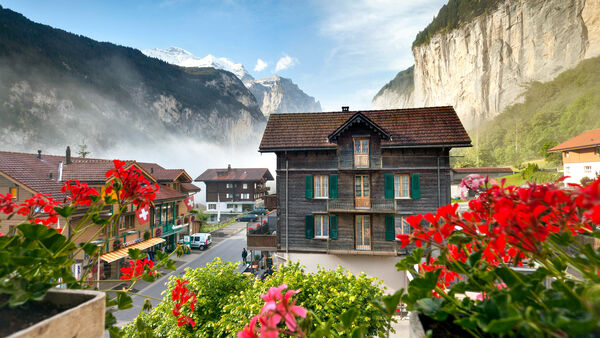Obeying the Power of the Alps in Switzerland’s Lauterbrunnen Valley
By Rick Steves

I learned to respect the power of nature in the shadow of Switzerland's towering Jungfrau, just south of Interlaken in the Lauterbrunnen Valley.
Avalanches are a part of life here — where humble yet tough mountain huts are built on the downhill side of giant and protective boulders. Hikers, hearing rivers of falling snow rumble in the distance, scan the edges of distant glaciers hoping for a glimpse of the icy action.
Aiming for the heart of the Alps, I catch my train from the belle-epoche resort town of Interlaken down a long, lush valley that leads south to the snowy peaks of the Eiger, Mönch, and Jungfrau. Once in my seat, I slide open the big window. The lush air, perfumed with the sweet, sweaty smell of freshly cut hay, fills my car.
Grassy banks speckled with alpine flowers remind me of my first ride on this train. While my girlfriend and I eagerly leaned out the window at a slow corner, overwhelmed by the views, a railroad worker surprised her with a bouquet of alpenroses offered through the window.
Below me a swollen stream charges noisily down the center of the valley, chattering excitedly about the wild ride it just survived. I crane my neck so I can see what all the excitement is about. Slowly we glide higher and higher into the Lauterbrunnen Valley, a glacier-cut garden of traditional Swiss lifestyles. This scenic rut has kept me from exploring the rest of Switzerland. From the Alps, I need nothing better.
The train drops me across from a grassy patch of land cleared by an avalanche. I remember bringing a tour group here. My group had seven days of Italy ground into their clothes. Not only had I been lifting spirits all day with promises of a self-serve laundry, I promised that our assistant guide would wash clothes for the entire group. Spirits were soaring as we approached the corner where I would reveal Lauterbrunnen's launderette. Then we saw it — or at least its freshly crumpled remains. Our launderette had been crushed under an avalanche. Everyone on our tour — except perhaps the assistant guide — was heartbroken.
Hiking past the bare patch of land where the launderette once stood, I head out of town and up the valley to a mighty waterfall.
For years, I've marveled at Staubbach Falls from a distance. Today, I climb for a close-up look. Scrambling up a pile of glacial gravel — as if struggling up a sand dune — I eventually work my way to the roaring base of the waterfall. Through the noisy storm, a black rock face soars 600 feet straight up. What was a river bursts over the cliff into a galaxy of excited drops. The sun glints through the mist as wet and fleeting prisms of color break into liquid fireworks.
I feel alone, engulfed in the roar. Then I notice a gray silhouette — a man — on the far side of the rainstorm. Suddenly, he grabs his head and falls to the ground. Racing to help him, I realize that Staubbach Falls hurls rocks (and that the small mountain of rocks he and I had climbed hadn't gotten here by dump truck). I feel under attack.
As I help the injured man climb down the glacial gravel, we pass a sign that causes us both to pause. It says, in very clear German: "Vorsicht: Steinschlag." Looking up past the hand holding his wounded head, he translates it for me: "Beware: falling rocks."
A little further up the valley, Trümmelbach Falls — a waterfall inside a mountain — makes its point differently, but with equal power. I buy my ticket and climb a series of wet switchbacks to a tunnel that leads deep into the mountain, to an elevator that zooms me up.
The elevator doors open into a misty cavern. The river roars, busy at work, cutting — like God's thundering bandsaw — through the mountain. Sheltering my camera from the angry mist, I try to capture this spectacle on film. A guard in an orange raincoat cautions me to watch my step. Last year, he tells me, a tourist, camera at his face, backed into Trümmelbach Falls. He was found six months later in a log jam. "His skin looked like wood," the guard says.
Hiking down the switchbacks to the valley floor, I look back and notice a Swiss flag. While many flags signal conquest, to me this tiny red-and-white Swiss flag flying from the top of Trümmelbach signals surrender. When I see nature flexing its muscles it seems determined to teach us that the best way to control her is to obey her.

